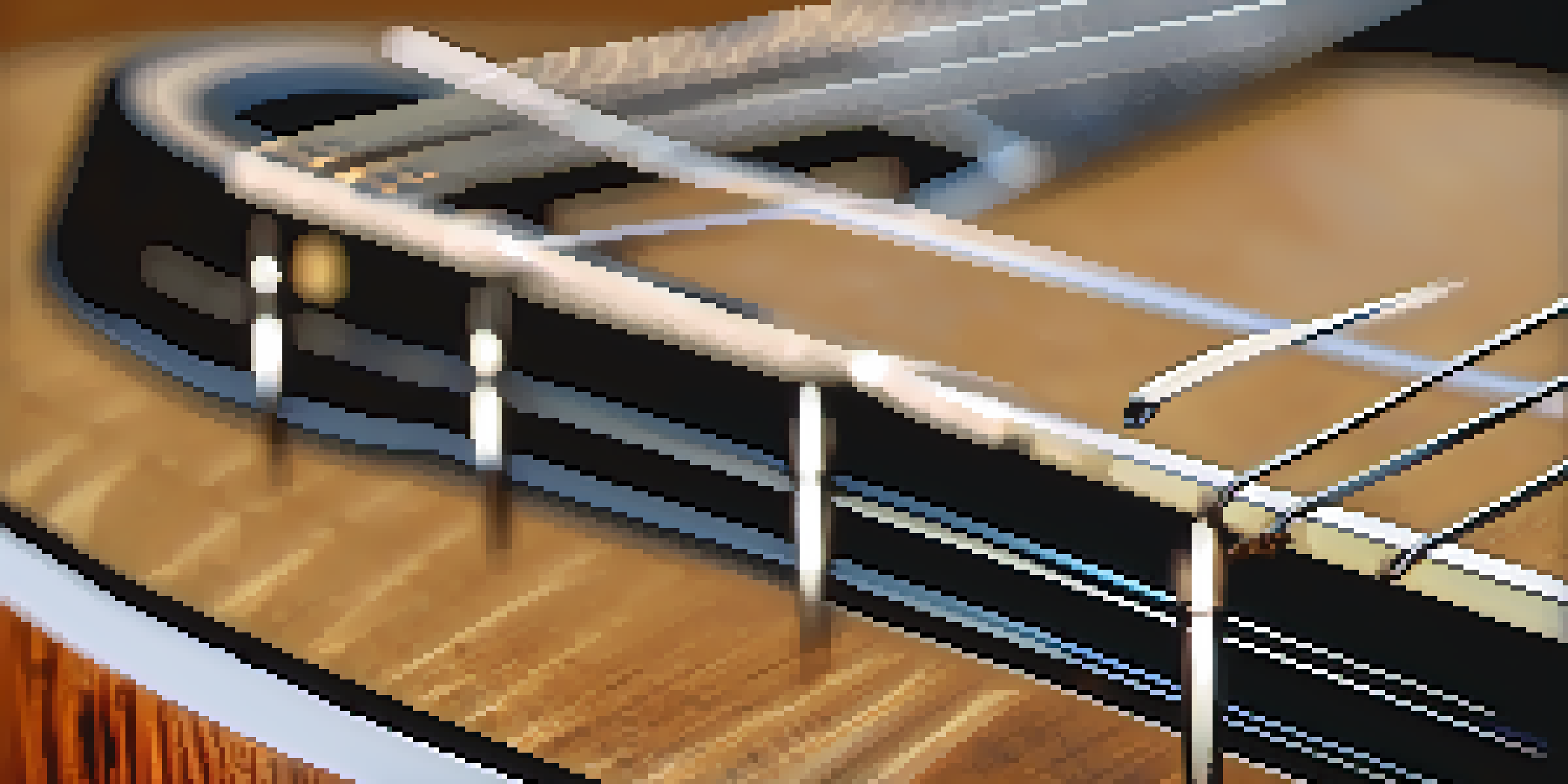Mastering Standard Notation for Guitar: Tips for Beginners

Understanding Standard Notation and Its Importance
Standard notation is a method of writing music that uses specific symbols to represent pitches and rhythms. For guitarists, mastering this notation opens up a world of music that goes beyond just tablature. It helps you understand the structure of music, making it easier to learn new pieces and improvise.
Music is the shorthand of emotion.
When you understand standard notation, you can communicate with other musicians more effectively. Whether you're jamming with friends or playing in a band, reading sheet music allows everyone to be on the same page. This skill is invaluable and elevates your musical collaboration.
Moreover, standard notation helps in developing your ear. As you read music, you begin to associate written notes with their sounds, strengthening your ability to recognize pitches and intervals. This foundational skill will enhance your overall musicianship and musical expression.
The Basics of Reading Standard Notation
At its core, standard notation consists of a staff, which is made up of five lines and four spaces. Each line and space corresponds to a specific note. For guitarists, the notes are placed on the staff to indicate which strings and frets to play, making it essential to familiarize yourself with how these notes look.

Understanding the different note values is also crucial. Notes can be whole, half, quarter, or eighth notes, each representing different lengths of time. Recognizing these values helps you play music as it is intended, maintaining the correct rhythm and flow.
Importance of Standard Notation
Understanding standard notation enhances communication among musicians and strengthens overall musicianship.
Additionally, learning about rests is important too. Rests indicate pauses in music, and knowing when to take a break adds depth to your playing. Just like in conversation, where pauses can emphasize points, rests in music can enhance the emotional impact of your performance.
Learning the Notes on the Guitar Fretboard
To read standard notation effectively, you need to know the notes on the guitar fretboard. Starting from the open strings, the notes are E, A, D, G, B, and E. Familiarizing yourself with these names is the first step in becoming a proficient reader.
Without music, life would be a mistake.
As you learn the notes, practice finding them on different frets. For instance, the first fret of the low E string is F, while the second fret is F#. This practice helps you connect the written notes to their actual positions on the guitar, reinforcing your understanding.
Using a visual aid, like a fretboard diagram, can assist in this learning process. Spend some time each day identifying notes on the diagram and then finding them on your actual instrument. This approach creates a solid foundation for reading standard notation.
Practicing with Simple Melodies
Once you have a grasp of the basics, start practicing with simple melodies written in standard notation. Children's songs or nursery rhymes are excellent choices because they often use basic note patterns and rhythms. This makes them accessible and enjoyable for beginners.
As you play these melodies, focus on your timing and accuracy. Use a metronome to help you maintain a steady tempo. This practice not only enhances your reading skills but also builds your confidence as a guitarist.
Basics of Reading Music
Familiarity with the staff, note values, and rests is essential for accurately interpreting and performing music.
Don't hesitate to play along with recordings of these melodies. This allows you to hear how the music should sound and helps you internalize the rhythm and phrasing. Over time, you'll find that your ability to read and play standard notation improves significantly.
Using a Combination of Tablature and Standard Notation
Many guitarists find it helpful to use both tablature and standard notation together. Tablature shows you exactly where to place your fingers, while standard notation provides a broader understanding of the music's structure. This dual approach can make learning new songs easier and more intuitive.
As you grow more comfortable with reading standard notation, try to transition to using it more exclusively. While tablature is great for quick learning, standard notation will deepen your understanding of music theory and improve your overall musicality.
Over time, you’ll notice that your ability to read standard notation will allow you to tackle more complex pieces. Embrace both forms of notation, but challenge yourself to read standard notation as much as possible to solidify your skills.
Utilizing Online Resources and Apps
In today’s digital age, there are countless online resources and apps designed to help guitarists master standard notation. Websites like musictheory.net offer interactive lessons and exercises that cater to all levels of experience. These platforms can make learning fun and engaging.
Many mobile apps also provide tools for practicing reading music. Some even include games that challenge your note recognition and timing. This gamified approach can motivate you to practice regularly, making learning feel less like a chore and more like a rewarding experience.
Practice and Patience Matter
Consistent practice and patience are key to mastering standard notation and improving your guitar skills over time.
Additionally, consider joining online forums or communities where you can share your progress and ask questions. Engaging with others who are on the same journey can provide support and encouragement, making your learning experience even more enjoyable.
Staying Consistent and Patient in Your Practice
Mastering standard notation is not something that happens overnight. It requires consistent practice and patience. Set aside a dedicated time each day to work on your reading skills, even if it's just for a few minutes. Small, regular practice sessions yield better results than infrequent, lengthy ones.
Celebrate your progress, no matter how small. Each time you successfully read a piece of music or recognize a note on the fretboard, you’re moving forward. Keep a practice journal to track your achievements, which can motivate you to stay committed to your learning.

Lastly, remember that everyone learns at their own pace. Don’t compare your journey to others; focus on your personal growth. With time and dedication, you'll find that reading standard notation becomes second nature, enriching your guitar-playing experience.